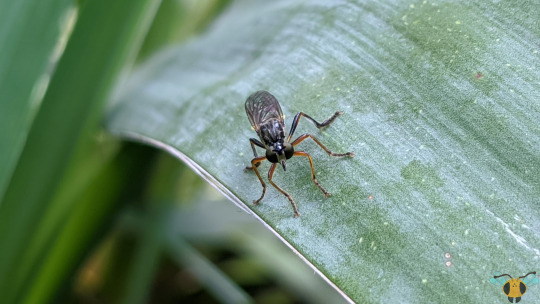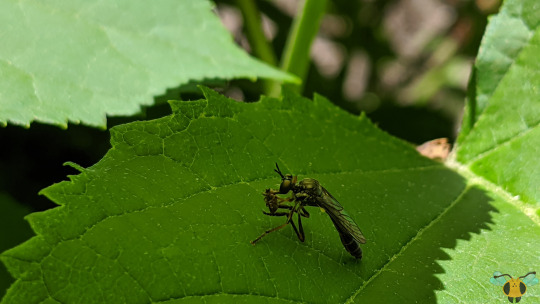#european longhorn robber
Explore tagged Tumblr posts
Text










European Longhorn Robber Fly - Dioctria hyalipennis
Firstly, you have have seen this specie on the blog before but with an entire different. Originally I pegged this specie as the "Common Robber Fly", but I've recently learned that this insect actually has a common name...as titled above (all prior posts have been updated to reflect this change). The common name of this lithe Robber Fly references its introduction to North America in the 1900's from Europe. The second part of its name doesn't reference what it hunts. It's far more likely that the reference is to the elongated antenna jutting from the depression between its eyes! The antenna length of this specie is a far cry from the absurd length some Longhorn Beetles' antennae. However, the Y-shaped antenna are quite long relative to the antennae of other Flies, especially given the Fly's size. With how the antennae are positioned and outstretch, they likely use the many chemoreceptors in conjunction with their great compound eyes to seek out surrounding prey in their vast, green environment. Based on the images here across many days of observation, their hunting strategy is very effective! As mentioned in earlier posts, Robber Flies will perch on a good vantage point and wait for a tantalizing insect to pass by. The Fly will then burst onto its prey, snaring its with its spindly legs and jabbing it with a sharp proboscis (technically, it's the hypopharynx)!
When the smaller insect is caught and neutralized, the Fly can enjoy its meal of liquified insect soup. Looking closely at the prey items caught here, this specie has expertise when it comes to catching smaller Flies or Fly-like insects such as small parasitic Wasps. One individual was even lucky enough to pierce into the thoracic gap of a Plant Bug (likely a Two-Spotted Grass Bug)! If they can overpower it, they can catch it, and in the case of the latter catch, I had a thought. When insects such as Plants Bugs (or Beetles) fly, they open their outer wings to reveal their flight wings. When they do so, they leave their abdomen vulnerable to attack from behind or the sides by a hunter of precision. Particularly, the sharp Flies of Asilidae who search for soft spots to subdue prey! In addition to the captured insects in the images above, this specie also targets Bees (some Sweat Bees in particular) and has also been reported to try its luck against Grasshoppers. Catching the latter would be very impressive given that it must be done mid-hop, but a sharp beak and strong legs can make the difference. On the subject of legs, look at them to distinguish from other similar genera of Asilidae. For example, Eudioctria species appear near identical, but with black legs. On the other hand, Micropanther Flies (Atomosia) have a similar build but with a more bulbous abdomen... and they are much, much smaller.
Pictures were taken on June 6, 10, 11 and 16, 2021 with a Google Pixel 4.
#jonny’s insect catalogue#ontario insect#fly#european longhorn robber fly#robber fly#european longhorn robber#diptera#insect#toronto#2021#june2021#nature#entomology#invertebrates#arthropods#photography#animals
6 notes
·
View notes
Photo










European Longhorn Robber Fly - Dioctria hyalipennis
Ooh, lunch time! While not as giant or spiny-legged as some of its relatives, the European Longhorn Fly is no less of a hunter. It may make do with smaller meals since it can get the jump on them and capture them, but this fills a good niche within the insect world. With closeups of the faces of these individuals, their piercing proboscis is on full display, and although it’s a short spike, other flying insects should be wary! True Bugs, Bees and even other Flies are on the menu if that sharp beak can strike a weak spot (in the case of the lattermost, the eyes are a prime target). It was only after looking through all the pictures I had taken that I learned these individuals had many several successful hunts and can engorge themselves on leg-snared prey. When any Robber Fly jabs an insect with their proboscis, they inject saliva that both immobilizes their quarry and dissolves the innards, granting the hunter a bountiful liquid meal. With insects drawn to gardens and greenery, the Asilidae hunters discover the best vantage points to scout for airborne prey and then pounce on them mid-flight!
For a good example, have a look at the individual in Picture 9. The Fly holds a Bee captive within the front 4 legs, and the Fly’s abdomen has begun to swell from all the drinking it’s doing. Actually, that’s a bit of a stretch as it’s more likely that the individual in that picture is a female D. hyalipennis. Field identification suggests that it’s only the females who have prominent orange coloration visible from the sides of the abdomen (the layers beneath the sclerotized exoskeleton), while the males have flatter, longer abdomens. I cannot make a comment on the length of the abdomen as I haven’t taken much notice between individuals over the years, but I’ll be more observant for future sightings and will try to provide a follow-up discussed the abdominal sections exposed beyond the wings. What I can say right now is that I never expected to see a Robber Fly using its abdomen as a resting post while it leisurely eats. The individual in Picture 5 has its enlarged black legs acting as armrests while the 2 front-most legs position the Bug against the face, like it’s eating chips right from the bag...with a straw. As a reminder, aside from placing the logo, I do not modify these pictures in any way. Nature has given us a great canvas to enjoy and learn from.
Pictures where taken on June 4, 6, 14, 15 and 20, 2020 with a Google Pixel 4. The common name of this insect was changed on June 28, 2024.
#jonny’s insect catalogue#ontario insect#fly#european longhorn robber fly#european longhorn robber#robber fly#diptera#insect#toronto#june2020#2020#entomology#nature#invertebrates#arthropods#photography#animals
4 notes
·
View notes
Photo


European Longhorn Robber Fly - Dioctria hyalipennis
For just a bit of a taste of what’s to come for future posts of this insect, here’s a sample from the Royal Botanical Gardens. As discussed in a previous predatory post (the Bee Killer Fly specifically), Robber Flies belong to the family within Diptera called Asilidae. Members of this Fly family are all distinguished by their predatory habits above all else: locating a food source with their keen eyesight, flying to it, and finally jabbing it with a sharp beak to digest them. In terms of physical characteristics, they also tend to have depressions in their heads (between their eyes) and enlarged back legs, sometimes lined with spikes. They are also generally of a respectable size. Compared to the bulky Bee Killer, this Fly is much more slender and spindly. Let appearances deceive you not, this Fly is as sharp as they come! Using its compound eyes, quick air speed and its sharp proboscis, it can successfully capture prey much larger than itself while midflight! Since this specie lacks bulk and large spines on its legs, it can’t just drop onto a Bee negligently, and hope to trap it. Instead, it must behave smarter and more efficiently with how it hunts. Having seen these Flies a few years now in both the front and back yards and now at the Botanical Gardens, I’ve seen their hunting strategies personally.
Robber Flies do not actively pursue prey in a chasing manner such as how the more swift Dragonflies overtake their catches in the meadow. Instead, they take on the role of aerial ambush hunters. This tactic may have given rise to the name, “Assassin Flies”, which sounds far more intimidating than Robber Fly. Anyways, the carnivorous Fly perches on open foliage and scouts the area, remaining perfectly still, only sharply twitching their head (and occasionally turning to face a new direction) to look around. Once they see an airborne insect within striking range, they’ll lunge off their plant and fly towards it, piercing a soft section of its prey with a quick jab. Occasionally, I have also seen Robber Flies fly to a closer perch before striking if they’ve noticed an insect that has landed close by. If they move closer, it’s to prepare for when the prey insect flies, and not to strike a ground target. Keep watch for these hunters, and you’ll see them take out plenty of pest insects...and the occasional Bee unfortunately, usually from May till the summer’s end. Unlike Horseflies (whose females require blood for their eggs), these Flies do not active pursue humans to obtain nourishment. They will jab a tightened hand should they feel threatened or constrained.
Pictures were taken on June 10, 2017 at the Royal Botanical Gardens with a Samsung Galaxy S4. The common name of this insect was changed on June 28, 2024.
#jonny’s insect catalogue#ontario insect#fly#european longhorn robber fly#european longhorn robber#robber fly#diptera#insect#royal botanical gardens#june2017#2017#entomology#nature#invertebrates#arthropods#photography#animals
0 notes